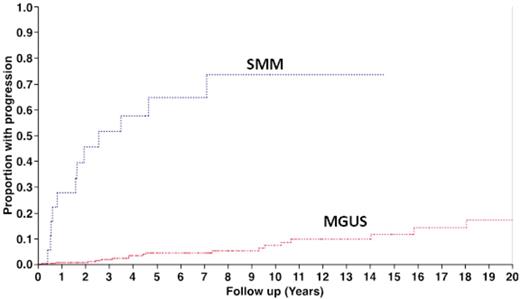Abstract
Background: Patients with monoclonal gammopathies typically have a single clone making a unique type of monoclonal protein, one heavy chain and one light chain. In a small proportion of patients, more than one (typically two) types of monoclonal protein can be seen and differ with respect to the heavy chain or light chain or both. There is limited information on the clinical course of patients with more than one monoclonal protein identified in their serum or urine.
Objectives: We report outcomes of patients with more than one monoclonal protein at our institution over the past thirty years.
Patients and Methods: We queried the existing clinical database to identify all patients with at least two different monoclonal protein types identified on serum or urine studies during the course of their disease. Retrospective chart review was performed on 551 patients, who had more than one type of monoclonal protein on electrophoresis and/or immunofixation.
Results: Among the entire study cohort (N=551), 461 pts (84%) had a biclonal pattern, 7 (1%) had a triclonal pattern and the remaining 83 (15%) had a monoclonal pattern at the time of initial positive study. The median age at the time of initial diagnosis was 69.7 years (range; 32-93); 359 (65%) were male. Among these, 390 were diagnosed as MGUS/BGUS, 18 with SMM, 36 with MM, 20 with WM, and rest with another lymphoproliferative disorders. The median duration between the initial detection of monoclonal protein and the emergence of the biclonal protein was 40 months for the 83 patients, who were monoclonal initially. The distributions of the dominant monoclonal proteins were GK (30%), GL (21%), MK (22%), ML (9%), AK (9%), and AL (8%). The distributions of the second monoclonal proteins were GK (27%), GL (24%), MK (16%), ML (15%), AK (10%), and AL (7%). Overall, 20 patients with a MGUS/BGUS progressed to smoldering or symptomatic myeloma, while 12 patients with an initial diagnosis of SMM progressed to MM. The median estimated follow up for the MGUS/BGUS group and those with SMM were 6.5 years (95% CI; 5, 7) and 9.8 (95% CI; 4, 13), respectively. This translates to 20 progressions over 3822 person years of follow up for the MGUS/BGUS patient group and 12 progressions over 131 person years of follow up for the SMM group. The rate of progression was ~1% per year for patients with MGUS/BGUS and the median estimated time to progression was 2.6 years for the SMM group. (Figure). In majority of patients, the dominant M spike increased with the disease progression.
Conclusion: Patients with biclonal gammopathies appear to have a similar rate of progression compared to what has been historically described for MGUS/ SMM population. For the patients who progressed and received treatment, both M proteins typically responded to therapy, and during relapse, the original dominant M protein typically reemerged as the dominant M protein.
Kumar:Janssen: Consultancy, Research Funding; Array BioPharma: Consultancy, Research Funding; Sanofi-Aventis: Consultancy, Research Funding; Onyx Pharmaceuticals: Consultancy, Research Funding; Millennium: The Takeda Oncology Co.: Consultancy, Research Funding; Celgene: Consultancy, Research Funding; Skyline Diagnostics: Membership on an entity's Board of Directors or advisory committees.
Author notes
Asterisk with author names denotes non-ASH members.


